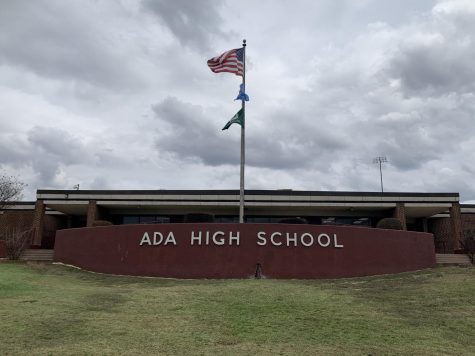Oklahoma schools face uncertainty amidst budget cuts
Schools across Oklahoma have been experiencing the effects of a $47 million cut approved by the State Board of Education.
The cut was due to a projected $157 million shortfall announced in December. The shortfall is expected to increase to around $900 million before the 2017 fiscal year, according to Rep. Earl Sears.
Each allocated agency has been forced to make three percent cuts as well.
State Secretary of Finance, Preston Doerflinger, blames oil for the deficit. Oil prices are still decreasing.
The school lunch match program will be cut 30 percent, staff development cut 50 percent, and AP teacher training and fee assistance cut around 55 percent. However, the STEM program will be affected the most with a 100 percent cut, which concerns many about the future of today’s students and potential workers.
“Many people consider it to be the engine that drives the economy,” said Dr. Frank Wang, the president of the Oklahoma School of Science and Mathematics, a school based on STEM.
Not only is the shortfall affecting STEM, but it’s also forcing schools that heavily rely on state dollars to close.
In a recent article published by Eric Swanson of the Ada News, it was revealed that the Ada Public School district is going to lose at least $167,000 in financial aid.
“So we’re looking at basically $167,874 and some change that we will lose between now and the end of the year,” Superintendent Pat Harrison said. The reductions will continue until June 30, the end of the 2016 fiscal year.
The cut went into effect on Jan. 1 of this year, and some call it “the first round of cuts,” since more are expected before the last day of school.
“It looks like there will be yet another cut this spring to this semester,” said State School Superintendent, Joy Hofmeister in a public statement mid-January. Statistics are looking at around an additional $19 million cut.
While Ada is not expected to experience the extent of the cut this year, there may be upcoming issues next year. Some AHS students are starting to speculate what that will mean for them.
“Budget cuts don’t just affect our supplies, what it directly affects is our education because we need [schools to] supply our minds with education,” said Ada High sophomore, Lakshana Ramakrishnan.
However, the recent find of 43.8 million dollars puts the State Board of Education’s budget cuts in question.
The money was found in the 1017 Fund, a dedicated revolving fund for education that’s been around since 1990. According to a recent Tulsa World article, it is estimated that around 700 million dollars will be allocated to the State Board of Education from the 1017 fund this year.
John Estus, spokesman of the Office of Management and Enterprise Services, credits the fund’s success to its diverse revenue stream. Sales taxes, horse track gaming revenues, and use tax revenues partially make up the fund.
Despite this discovery, however, State Schools Superintendent, Joy Hofmeister, still advises schools to brace for more cuts.
Controversy has arisen on how such a critical fund was just now found. According to Oklahoma Watch, Estus said that “the board only looks at current incoming revenue, and does not look at carryover or reserve balances when making its projections.”
“It is very concerning that our elected officials did not keep track of the funding that they had allotted for education, because that would greatly have benefited public education,” said Ada High School teacher Cara Waters.
Although the 1017 fund has brought a safety cushion for public schools, it concerns many about how Oklahoma’s budgeting is being handled.
Several schools have been looking into making significant changes in order to handle the budget cuts better.
Ever since late November of last year, several Oklahoma school districts have been looking into four-day school weeks, among them the Newcastle, Vanoss and Tulsa Public School districts.
The move to a shorter school week is projected to help in saving money for the whole school year, like cutting transportation and food expenses.
“It would be beneficial to school districts given our current situation,” said Ada High School teacher Shawn Freeman.
According to the Oklahoma State Department of Education, around 35 districts in the state of Oklahoma are already running on the four-day schedule. Schools have been able to cut off 15 to 46 days from their calendars by extending the length of the school day while still meeting the state’s 180-day minimum.
“It makes sense that we would switch to a four-day week since we don’t have the money to do anything,” said Ada High School junior, Maggie Donaghey.
While this proposition offers several solutions, some people are not supportive of the idea, one of them being State School Superintendent Joy Hofmeister. “Frankly, I think it’s a short-term, promotional tactic to attract teachers at the expense of kids,” said Hofmeister in an interview around late November.
Parents and guardians are also concerned about child care, since some rely on the traditional five-day schedule to occupy and take care of their children throughout the day.
Regardless, if the change is elected, it is scheduled to begin next fall.
Angelle is a photographer and reporter for the Cougar Call. She plays the clarinet in band and is a sophomore class representative in Student Council....











Braden moore • Mar 11, 2018 at 7:14 pm
Four day school weeks would be the best way to fix the budget crisis. I agree with Mrs.Waters when she says it is a disgrace the elected officials don’t keep up with what is being spent. They are elected for a reason to be our (the people’s) voices.
Matthew Lovett • May 12, 2016 at 8:46 am
It makes sense to cut budget in schools and not something like instead of the millions of dollars spent on federals every year…
Nate Pulliam • May 5, 2016 at 10:56 am
The budget cuts are not helping schools at all. The state of Oklahoma is slowly draining public schools dry and the education is being affected. Now public schools are having to cut teachers and make classroom sizes bigger. So extrudent expenses on schools are a big impact on the future. Just like the pushers that could of funded 4 teachers salaries for the next year.
Daniel Bratcher • Apr 22, 2016 at 10:56 am
The budget cuts will be a problem to us as students and to the school as well. But we will need to make due with what we have. I am in favor of 4-day school weeks if it will result in the school having more money to spend for our education.
Kishan Bhula • Apr 4, 2016 at 10:11 pm
I think a four day school week is our best bet due to the budget cuts. It would cut the cost of breakfast, lunch, utility bills, and the bus runs. AP classes are prepaing students for college and if they aren’t getting the courses they need they will be going to college with zero experience and it will be hard for them to succeed in college.
Vaughn Appleman • Apr 1, 2016 at 1:33 pm
The budget cuts not only hurt the students but hurt everyone because the students do not get the education they need to say get a job or go further in life.
Maci Neal • Mar 22, 2016 at 11:02 am
our school needs money, we’re important too)):